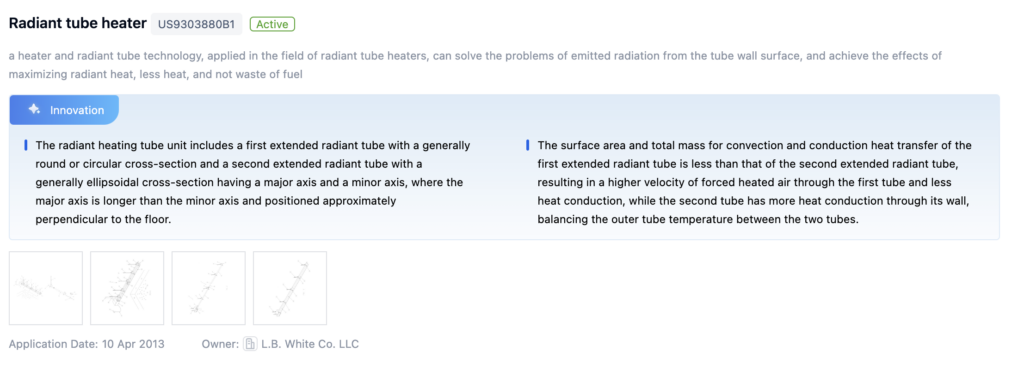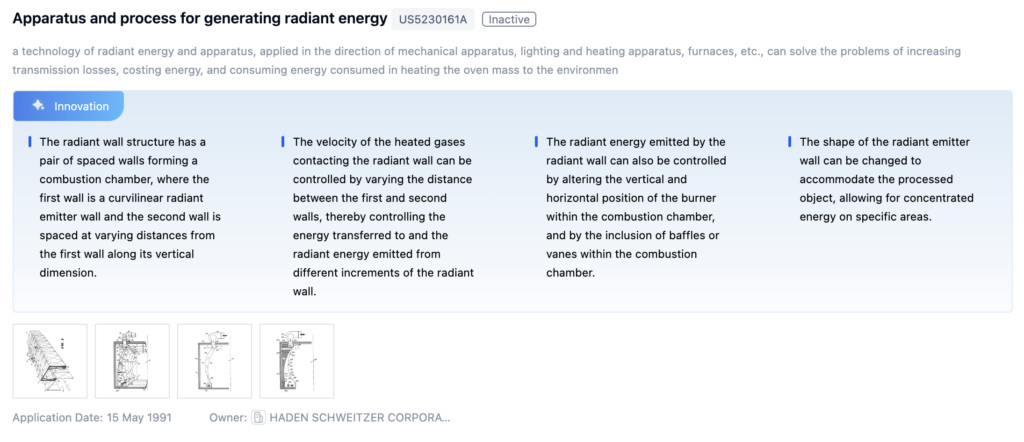
Technical Background and Objectives
The technical field of radiant energy, specifically focusing on radiant heat, has witnessed a sustained interest and research activity over the years, as evidenced by the patent application and literature data provided.
The patent application data shows an initial increase in the number of applications, reaching a peak in a certain year, followed by a gradual decline. This trend suggests that there was a period of intense innovation and research efforts in this field, potentially driven by emerging technologies or market demands. However, the subsequent decline in patent applications does not necessarily indicate a diminishing interest in the field. Rather, it could signify a shift towards consolidation and refinement of existing technologies, or a transition towards different areas within the broader domain of radiant energy.

Interestingly, the literature data exhibits a different pattern. While the number of patent applications declined after the peak, the number of related literature publications remained relatively stable, with some fluctuations. This observation implies that academic research and theoretical investigations in the field of radiant heat continued to be active, even as the rate of new patent filings slowed down. This discrepancy between patent and literature trends could be attributed to factors such as the time lag between academic research and commercial application, or the exploration of more fundamental aspects of radiant heat that may not immediately translate into patentable technologies.
The sustained presence of literature publications, albeit at varying levels, suggests that the field of radiant heat remains an area of interest for researchers and academics. This could be driven by the potential applications of radiant heat in various industries, such as energy, manufacturing, or materials science, or by the need to address challenges related to energy efficiency, sustainability, or thermal management.
Overall, the provided data indicates that while the rate of patent filings in the field of radiant heat may have slowed down after an initial surge, the underlying research and academic activities in this area have continued, potentially laying the groundwork for future technological advancements or breakthroughs.
To get a detailed scientific explanations of radiant energy, try Eureka.
Technical Current Status Analysis
Radiant energy, also known as electromagnetic radiation, is a form of energy that is transmitted through space in the form of waves or particles. One of the most significant applications of radiant energy is in the generation and utilization of radiant heat, which has found widespread use in various fields.
In the industrial sector, radiant heat is extensively employed in processes such as heat treatment, drying, curing, and melting. For instance, infrared heaters are commonly used in the manufacturing of plastics, ceramics, and composites, as they provide efficient and uniform heating. Additionally, radiant heat plays a crucial role in the food processing industry, where it is utilized for drying, roasting, and baking operations.
The construction and building industry also benefits from radiant heat technology. Radiant floor heating systems, which utilize infrared radiation to directly heat surfaces and objects, offer energy-efficient and comfortable heating solutions for residential and commercial buildings.
In the field of renewable energy, concentrated solar power (CSP) systems harness radiant energy from the sun to generate electricity. These systems use mirrors or lenses to concentrate sunlight onto a receiver, where the radiant heat is absorbed and converted into thermal energy, which is then used to drive a turbine or generate steam for power generation.
Radiant heat also finds applications in the medical field, particularly in therapeutic treatments. Infrared lamps and other radiant heat sources are used for localized heating in physical therapy, pain management, and wound healing processes.
However, despite its numerous applications, the utilization of radiant heat also presents several technical challenges and limitations. The utilization of radiant heat involves several technical characteristics and challenges:
Efficiency and energy conversion
The conversion of radiant energy into usable heat is not always efficient, and there can be significant energy losses during the process. Improving the efficiency of radiant heat generation, transfer, and utilization is a continuous challenge.
Selective absorption and emission
Different materials have varying abilities to absorb and emit radiant energy at different wavelengths. Developing materials and coatings with tailored absorption and emission properties is crucial for optimizing radiant heat systems.
Temperature control and uniformity
Precise control and uniform distribution of radiant heat are essential in many applications, such as industrial processes and building heating systems. Achieving and maintaining the desired temperature profiles can be challenging, particularly in large-scale systems.
Environmental impact and sustainability
The generation and utilization of radiant heat often involve the consumption of energy resources and the potential release of greenhouse gases or other emissions. Addressing environmental concerns and promoting sustainable practices in radiant heat technologies is an ongoing challenge.
Safety considerations
Exposure to high-intensity radiant heat can pose safety risks, such as burns or fire hazards. Proper shielding, insulation, and safety protocols are necessary to mitigate these risks in industrial and commercial applications.
Integration and system design
Incorporating radiant heat technologies into existing systems or designing new systems that effectively utilize radiant heat requires careful engineering and system integration considerations.
To address the technical challenges and promote the advancement of radiant heat technologies, the following technological paths can be explored:
Material research and development
Investigate and develop advanced materials with tailored optical and thermal properties for efficient absorption, emission, and transfer of radiant energy. This includes the exploration of nanomaterials, metamaterials, and coatings with unique spectral characteristics.
Computational modeling and simulation
Leverage computational fluid dynamics (CFD) and finite element analysis (FEA) tools to model and simulate radiant heat transfer processes, optimize system designs, and predict performance under various operating conditions.
Advanced control systems
Develop intelligent control systems and algorithms for precise temperature regulation, uniform heat distribution, and real-time monitoring and adjustment of radiant heat systems.
Renewable energy integration
Explore the integration of radiant heat technologies with renewable energy sources, such as concentrated solar power (CSP) systems, to promote sustainable and environmentally friendly energy solutions.
Hybrid and combined systems
Investigate the combination of radiant heat technologies with other heating or cooling systems, such as convective or conductive systems, to improve overall efficiency and performance.
Additive manufacturing and advanced fabrication
Leverage additive manufacturing techniques (e.g., 3D printing) and advanced fabrication methods to produce customized components or systems with optimized geometries and properties for radiant heat applications.
Sensor and monitoring technologies
Develop advanced sensor technologies and monitoring systems to accurately measure and characterize radiant heat fluxes, temperatures, and system performance, enabling data-driven optimization and maintenance.

Research Content And Objectives
1 [Research Objectives]
The primary objective of this research project is to advance the understanding and application of radiant energy, specifically in the context of radiant heat. By leveraging the principles of radiant energy transfer, we aim to develop innovative solutions that can enhance thermal management, energy efficiency, and sustainability across various industries. The research will focus on exploring the fundamental mechanisms of radiant heat transfer, as well as investigating novel materials, systems, and technologies that can harness and control radiant energy effectively.
2 [Research Direction and Focus]
The research direction and focus will encompass the following key areas:
-2.1 [Fundamental Studies on Radiant Heat Transfer]
This research area will delve into the theoretical foundations of radiant heat transfer, including the study of electromagnetic radiation, thermal radiation properties of materials, and the interaction between radiant energy and matter. Numerical simulations and analytical models will be developed to gain a deeper understanding of the underlying physics and to predict the behavior of radiant heat transfer in various scenarios.
-2.2 [Advanced Materials for Radiant Energy Applications]
Researchers will explore the development of advanced materials that can effectively absorb, emit, or manipulate radiant energy. This may include the investigation of nanomaterials, metamaterials, and spectrally selective coatings. The goal is to create materials with tailored optical and thermal properties, enabling enhanced control over radiant heat transfer and improved energy efficiency.
-2.3 [Radiant Energy Systems and Technologies]
This research area will focus on the design, development, and optimization of radiant energy systems and technologies. This may include radiant heating and cooling systems for buildings, solar thermal collectors, thermal energy storage systems, and industrial processes that leverage radiant heat transfer. Emphasis will be placed on improving energy efficiency, reducing environmental impact, and enhancing overall system performance.
-2.4 [Modeling and Simulation]
Computational modeling and simulation will play a crucial role in this research project. Advanced numerical techniques, such as finite element analysis, computational fluid dynamics, and ray tracing methods, will be employed to model and simulate radiant heat transfer phenomena. These simulations will aid in the design and optimization of radiant energy systems, as well as provide insights into the underlying physical processes.
-2.5 [Experimental Validation and Testing]
Experimental studies will be conducted to validate the theoretical models, numerical simulations, and the performance of developed materials and systems. State-of-the-art measurement techniques, such as infrared thermography, spectroscopy, and calorimetry, will be utilized to characterize the properties of materials and evaluate the efficiency of radiant energy systems under various operating conditions.
Throughout the research project, emphasis will be placed on interdisciplinary collaboration, leveraging expertise from fields such as materials science, thermal engineering, optics, and renewable energy. The ultimate goal is to contribute to the advancement of radiant energy technologies, promoting energy efficiency, sustainability, and innovative solutions for a wide range of applications.
Technical Development Roadmap
In the radiant energy industry’s technological system, three primary areas are witnessing significant advancements: Concentrated Solar Power (CSP) Technologies, Photovoltaic (PV) Cell and Module Technologies, and Solar Forecasting and Resource Assessment. Within the CSP domain, research is actively progressing on molten salt heat transfer and storage systems, optimizing heliostat field control, and integrating thermal energy storage with CSP plants. These developments aim to enhance the efficiency, reliability, and scalability of CSP systems for large-scale solar energy utilization.
The PV cell and module technologies sector is experiencing breakthroughs in perovskite solar cell development and commercialization, tandem solar cell architectures for high efficiency, and advanced light trapping and anti-reflection coatings. These innovations hold the potential to significantly boost the performance and cost-effectiveness of photovoltaic systems, making solar energy more competitive and accessible.
Complementing the hardware advancements, the solar forecasting and resource assessment field is leveraging satellite-based solar resource mapping and monitoring, machine learning techniques for solar power forecasting, and integrating weather data for improved forecasting accuracy. These efforts are crucial for optimizing solar energy generation, grid integration, and resource management, enabling more reliable and efficient solar power deployment.
Overall, the radiant energy industry’s technological system exhibits a multifaceted approach, addressing various aspects of solar energy generation, storage, and utilization. The synergistic advancements across these technological fields are poised to drive the industry’s growth, enhance solar energy’s competitiveness, and contribute to a more sustainable and renewable energy future. With continued innovation and collaboration, the radiant energy industry is well-positioned to play a pivotal role in the global transition towards clean and sustainable energy sources.

Main Player Analysis
The radiant energy and radiant heat technology sector is a rapidly evolving field with several major players actively engaged in research and development. Companies like Matsushita Electronics Corp., Mitsubishi Electric Corp., and Canon, Inc. have extensive patent portfolios, indicating their strong focus on commercializing radiant energy technologies. Academic institutions like the Russian Academy of Sciences and Purdue University are also making significant contributions through scholarly publications, exploring various aspects of radiant energy and its applications.
Matsushita Electronics Corp.
Matsushita Electronics Corp. is a leading player in the radiant energy and radiant heat technology sector, with a vast portfolio of 5,356 patents. Their research efforts span a wide range of applications, including heating systems, energy-efficient devices, and thermal management solutions. Matsushita’s extensive patent portfolio suggests a strong commitment to developing innovative radiant energy technologies and securing intellectual property rights. Potential applications of Matsushita’s radiant energy technologies include radiant heating systems for residential and commercial buildings, infrared heating devices for industrial processes, and thermal management solutions for electronics and appliances.
Mitsubishi Electric Corp.
Mitsubishi Electric Corp. is another prominent player in the radiant energy and radiant heat technology sector, with a significant patent portfolio of 3,114 patents. Their research efforts are likely focused on developing radiant energy technologies for various applications, such as heating systems, energy-efficient devices, and thermal management solutions. Mitsubishi’s strong patent portfolio indicates their commitment to innovation and protecting their intellectual property. Potential applications of Mitsubishi’s radiant energy technologies may include radiant heating systems for buildings, infrared heating devices for industrial processes, and thermal management solutions for electronics and appliances, similar to those of Matsushita Electronics Corp.
Russian Academy of Sciences
Russian Academy of Sciences is a leading academic institution contributing to the advancement of radiant energy and radiant heat technologies through scholarly publications. With 40 publications in this field, their research covers a diverse range of topics, including nanofluid-based solar collectors, laser-material interactions, infrared heaters, and thermal modeling of nuclear reactors. The Academy’s research efforts provide valuable insights and contribute to the fundamental understanding of radiant energy and its applications. Potential applications stemming from the Russian Academy of Sciences’ research include nanofluid-based solar thermal collectors, laser-based material processing, infrared heating systems for industrial and residential applications, and thermal modeling for nuclear reactor safety and efficiency.
Purdue University
Purdue University is a prominent academic institution actively engaged in research related to radiant energy and radiant heat technologies, with 45 publications in this field. Their research efforts cover a diverse range of topics, including thermoelectric radiant heat recovery, model predictive control for building energy systems, infrared radiation-assisted evaporation, and thermal hyperconductivity. Purdue’s research contributions provide valuable insights and advance the fundamental understanding of radiant energy and its applications. Potential applications stemming from Purdue University’s research include thermoelectric radiant heat recovery systems for industrial processes, model predictive control strategies for energy-efficient buildings, infrared radiation-assisted combustion and evaporation processes, and thermal management solutions leveraging hyperbolic media and radiative energy transport.
Canon, Inc.
Canon, Inc. is a prominent player in the radiant energy and radiant heat technology sector, with a significant patent portfolio of 3,135 patents. Their research efforts are likely focused on developing radiant energy technologies for various applications, such as imaging devices, printing technologies, and thermal management solutions. Canon’s strong patent portfolio indicates their commitment to innovation and protecting their intellectual property in this field. Potential applications of Canon’s radiant energy technologies may include radiant heating systems for imaging devices and printers, thermal management solutions for electronics and imaging equipment, and radiant energy-based printing and imaging technologies.
Current Technical Solution Overview
1. Radiant energy heat exchangers and collectors
These inventions relate to devices and systems that utilize radiant energy for heating purposes. They include heat exchangers, collectors, and panels designed to absorb, transfer, or concentrate radiant energy, often from solar or other radiant sources. The radiant energy is then used for heating or other applications.
Radiant energy heat exchangers for furnaces and heating systems
These heat exchangers are designed to efficiently transfer radiant heat energy from a heat source, such as a furnace or burner, to a working fluid or air. They are commonly used in industrial furnaces, radiant tube heaters, and heating systems to recover and utilize the radiant energy for heating purposes.
Radiant energy collectors for solar and renewable energy applications
These devices are designed to capture and concentrate radiant energy from the sun or other sources for conversion into usable forms of energy, such as heat or electricity. They often employ reflective surfaces, lenses, or other optical components to focus the radiant energy onto a receiver or absorber.
Heat exchangers with integrated radiant energy recovery and utilization
These heat exchangers are designed to recover and utilize radiant heat energy that would otherwise be wasted. They often incorporate radiant energy absorbers or receivers within the heat exchanger structure, allowing the captured radiant energy to be transferred to a working fluid or air for heating or other applications.
Radiant energy control and shielding systems
These systems are designed to control, block, or redirect radiant energy, such as heat or light, for various applications. They may involve the use of reflective or absorptive materials, shutters, or other mechanisms to regulate the flow or distribution of radiant energy.
Radiant energy conversion and utilization devices
These devices are designed to convert radiant energy, such as solar radiation or infrared radiation, into other forms of energy, such as electricity or mechanical energy. They may employ thermoelectric, photovoltaic, or other conversion mechanisms to harness the radiant energy for practical applications.
2. Radiant energy conversion and power generation
These inventions involve converting radiant energy into other forms of energy, such as mechanical or electrical energy. They may include devices like radiant energy converters, power sources, or rotary heat engines that harness radiant energy for power generation or other energy-related applications.
Radiant energy conversion systems for generating electricity
These systems involve converting radiant energy, such as solar energy, into electrical energy. This can be achieved through various techniques, including photovoltaic cells, thermoelectric generators, or other energy conversion mechanisms.
Radiant energy collectors and concentrators
These systems focus on collecting and concentrating radiant energy, such as solar radiation, for various applications like heating, power generation, or industrial processes. They may involve mirrors, lenses, or other optical components to concentrate the radiant energy.
Radiant energy heat exchangers and thermal management
These systems involve the transfer and management of radiant heat energy, such as in heat exchangers, thermal control systems, or radiant heating/cooling applications. They may involve specialized materials, coatings, or designs to facilitate efficient heat transfer.
Radiant energy measurement and monitoring
These systems involve the measurement, detection, and monitoring of radiant energy, such as in radiation detectors, energy meters, or monitoring devices. They may employ various sensing techniques and instruments to accurately measure and quantify radiant energy levels.
Radiant energy thermochemical processing and industrial applications
These systems involve the use of radiant energy for various thermochemical processes, such as in chemical reactors, industrial heating, or material processing applications. They may involve specialized designs or configurations to efficiently utilize radiant energy for specific processes.
3. Radiant energy measurement and detection
These inventions relate to methods and devices for measuring, detecting, or controlling radiant energy. They may include radiant energy meters, sensors, or detectors that can measure or monitor the intensity, wavelength, or other properties of radiant energy.
Radiant energy detection devices and methods
Various devices and methods are disclosed for detecting and measuring radiant energy, such as radiant heat or electromagnetic radiation. These include detectors, sensors, and measurement devices that can accurately detect and quantify the intensity, wavelength, or other characteristics of radiant energy.
Radiant energy collectors and converters
Apparatuses and systems are described for collecting and converting radiant energy, such as solar energy or thermal radiation, into other forms of energy like electricity or heat. These devices often employ specialized materials or structures to efficiently absorb and harness radiant energy.
Radiant heat flux and energy transfer measurement
Methods and instruments are disclosed for measuring the transfer of radiant heat energy, such as heat flux or radiant heat flow through materials or surfaces. These techniques can be used to characterize thermal properties, monitor processes involving radiant heat transfer, or optimize energy-efficient systems.
Radiant energy control and heat exchange systems
Systems and methods are described for controlling and managing the transfer of radiant energy, such as in heat exchange or thermal processing applications. These may involve radiant energy reflectors, absorbers, or other components to regulate the flow of radiant heat or energy.
Radiant energy diagnostic and imaging techniques
Techniques are disclosed for using radiant energy, such as electromagnetic radiation or thermal imaging, for diagnostic or analytical purposes, including medical imaging, material analysis, or process monitoring. These methods often involve detecting and interpreting radiant energy signals from various sources or materials.
4. Radiant energy heating and combustion systems
These inventions involve heating systems, combustion devices, or boilers that utilize radiant energy as a heat source. They may include radiant heat tubes, radiant heat recovery heaters, or radiant heat furnaces that employ radiant energy for heating purposes or in combustion processes.
Radiant heating systems and devices
Various systems and devices are disclosed for providing radiant heating through the use of radiant energy sources, such as radiant tubes or combustion chambers. These systems can be used for industrial heating applications, furnaces, or heating of living spaces.
Heat exchangers and collectors for radiant energy
Heat exchangers and collectors are designed to capture and transfer radiant energy for heating purposes. These devices can utilize solar radiant energy or radiant energy from combustion processes to provide heating or generate mechanical energy.
Radiant heating systems with combustion
These systems combine radiant heating with combustion processes, where the radiant energy generated from combustion is utilized for heating purposes. The combustion can take place in radiant tubes, combustion chambers, or furnaces.
Radiant energy processing and treatment systems
Radiant energy is utilized in various processing and treatment systems, such as thermochemical processing, heat treatment furnaces, or chemical reactors. These systems leverage the radiant energy for heating, processing, or treating materials.
Radiant energy processing and treatment systems
Radiant energy is utilized in various processing and treatment systems, such as thermochemical processing, heat treatment furnaces, or chemical reactors. These systems leverage the radiant energy for heating, processing, or treating materials.
Energy-efficient radiant heating systems
These systems focus on improving the energy efficiency of radiant heating by incorporating features such as heat recovery, insulation, or optimized heat transfer mechanisms. The goal is to reduce energy consumption while maintaining effective radiant heating.
5. Radiant energy control and utilization
These inventions relate to methods and systems for controlling, directing, or utilizing radiant energy. They may include devices for controlling radiant energy, radiant energy receivers or reflectors, or systems that employ radiant energy for specific applications, such as manufacturing processes or cooking.
Radiant energy collection and conversion systems
Various systems and methods are disclosed for collecting, concentrating, and converting radiant energy from sources such as the sun or other heat sources. These systems may involve the use of reflectors, lenses, or other optical components to focus the radiant energy onto a receiver or converter, which can then convert the energy into heat, electricity, or other forms of usable energy.
Radiant energy heat exchangers and thermal management
These inventions relate to the use of radiant energy for heating and cooling purposes, often involving heat exchangers or thermal management systems. The radiant energy can be utilized for heating or cooling fluids, air, or other substances, and may involve the use of specialized materials or coatings to enhance the absorption or emission of radiant energy.
Radiant energy detectors and measurement devices
These inventions involve devices and methods for detecting, measuring, or monitoring radiant energy, such as infrared radiation, visible light, or other forms of electromagnetic radiation. These devices may use various sensing technologies, such as photodetectors, thermopiles, or other radiation-sensitive components, and may be used in applications such as environmental monitoring, industrial process control, or scientific instrumentation.
Radiant energy selective control and filtering
These inventions relate to the selective control or filtering of radiant energy, such as the transmission, reflection, or absorption of specific wavelengths or frequencies of radiation. This may involve the use of specialized materials, coatings, or optical components designed to selectively transmit, reflect, or absorb certain portions of the radiant energy spectrum, with applications in areas such as solar control, thermal management, or optical filtering.
Radiant energy storage and chemical conversion
These inventions involve the storage or chemical conversion of radiant energy, such as the use of photochemical reactions or thermochemical processes to store or release energy in the form of chemical bonds or phase changes. This may involve the use of specialized materials or catalysts that can absorb and store radiant energy, or release stored energy in the form of heat or other usable forms.
Key Patent Interpretation
Patent 1

Patent:Radiant tube heater
Abstract:a heater and radiant tube technology, applied in the field of radiant tube heaters, can solve the problems of emitted radiation from the tube wall surface, and achieve the effects of maximizing radiant heat, less heat, and not waste of fuel
Legal status:Active
Application Date:10 Apr 2013
Inventor:L.B. White Co. LLC
Core Invention Points:
| Point 1 | Point 2 | Point 3 |
| The radiant heating tube unit includes a first extended radiant tube with a generally round or circular cross-section and a second extended radiant tube with a generally ellipsoidal cross-section having a major axis and a minor axis, where the major axis is longer than the minor axis and positioned approximately perpendicular to the floor. | The surface area and total mass for convection and conduction heat transfer of the first extended radiant tube is less than that of the second extended radiant tube, resulting in a higher velocity of forced heated air through the first tube and less heat conduction, while the second tube has more heat conduction through its wall, balancing the outer tube temperature between the two tubes. | No data |
Patent 2

Patent:High-efficiency heat exchangers for non-self-preheating gas burner radiant tubes
Abstract:A gas burner, radiant tube technology, applied in the direction of heat exchanger type, indirect heat exchanger, heat exchange equipment, etc., can solve the problem of limited increase in heat exchange wall area, prolonging flue gas stroke and heat exchange time, heat exchange It can solve the problems of high temperature corrosion of the device, so as to achieve the effect of expanding the effective heat exchange wall area, prolonging the flow of flue gas, and improving the surface heat transfer coefficient.
Legal status:Inactive
Application Date:26 Aug 2015
Inventor:Wuhan Iron & Steel Co., Ltd.
Core Invention Points:
| Point 1 | Point 2 | Point 3 |
| The design of the heat exchange inner tube and heat exchange jacket realizes direct inter-wall heat exchange between the combustion-supporting air and the flue gas on the outer surface of the heat exchange inner tube and the inner and outer surfaces of the heat exchange jacket, greatly expanding the effective heat exchange wall area of the heat exchanger under limited layout space conditions. | The heat exchanger realizes countercurrent heat exchange between the combustion-supporting air in the heat exchange inner tube section and the flue gas, as well as parallel flow heat exchange in the heat exchange jacket section, which not only improves the surface heat transfer coefficient of the heat exchanger, but also extends the effective heat exchange stroke of the combustion-supporting air, greatly improving the heat exchange efficiency of the heat exchanger. | The spiral fins on the outer jacket of the heat exchange inner tube and heat exchange jacket not only realize fin heat exchange enhancement on the heat exchange wall, but also extend the flow path and heat exchange time of the flue gas. |
Patent 3

Patent:Apparatus and process for generating radiant energy
Abstract:a technology of radiant energy and apparatus, applied in the direction of mechanical apparatus, lighting and heating apparatus, furnaces, etc., can solve the problems of increasing transmission losses, costing energy, and consuming energy consumed in heating the oven mass to the environmen
Legal status:Inactive
Application Date:15 May 1991
Inventor:
Core Invention Points:
| Point 1 | Point 2 | Point 3 |
| The radiant wall structure has a pair of spaced walls forming a combustion chamber, where the first wall is a curvilinear radiant emitter wall and the second wall is spaced at varying distances from the first wall along its vertical dimension. | The velocity of the heated gases contacting the radiant wall can be controlled by varying the distance between the first and second walls, thereby controlling the energy transferred to and the radiant energy emitted from different increments of the radiant wall. | The radiant energy emitted by the radiant wall can also be controlled by altering the vertical and horizontal position of the burner within the combustion chamber, and by the inclusion of baffles or vanes within the combustion chamber. |
Possible Research Directions
1. Radiant energy heat exchangers:
These inventions relate to heat exchangers that utilize radiant energy for heating or cooling purposes. They typically involve the transfer of heat between a radiant energy source and a working fluid, enabling efficient heat transfer and energy utilization.
2. Radiant energy collection and conversion systems:
These inventions focus on systems and methods for collecting and converting radiant energy, such as solar energy, into usable forms like heat or electricity. They often involve the use of specialized collectors, concentrators, and conversion mechanisms.
3. Radiant energy detection and measurement devices:
These inventions relate to devices and methods for detecting and measuring radiant energy, such as infrared radiation or electromagnetic waves. They can be used for various applications, including environmental monitoring, security, and scientific research.
4. Radiant energy heating and combustion systems:
These inventions involve the use of radiant energy for heating purposes, such as in boilers, furnaces, or combustion systems. They often aim to improve efficiency, reduce emissions, or provide better control over the heating process.
5. Radiant energy receivers and concentrators:
These inventions relate to devices and systems designed to receive and concentrate radiant energy, such as solar radiation. They can be used in various applications, including solar power generation, heating, and industrial processes.
If you want an in-depth research or a technical report, you can always get what you want in Eureka Technical Research. Try now!

